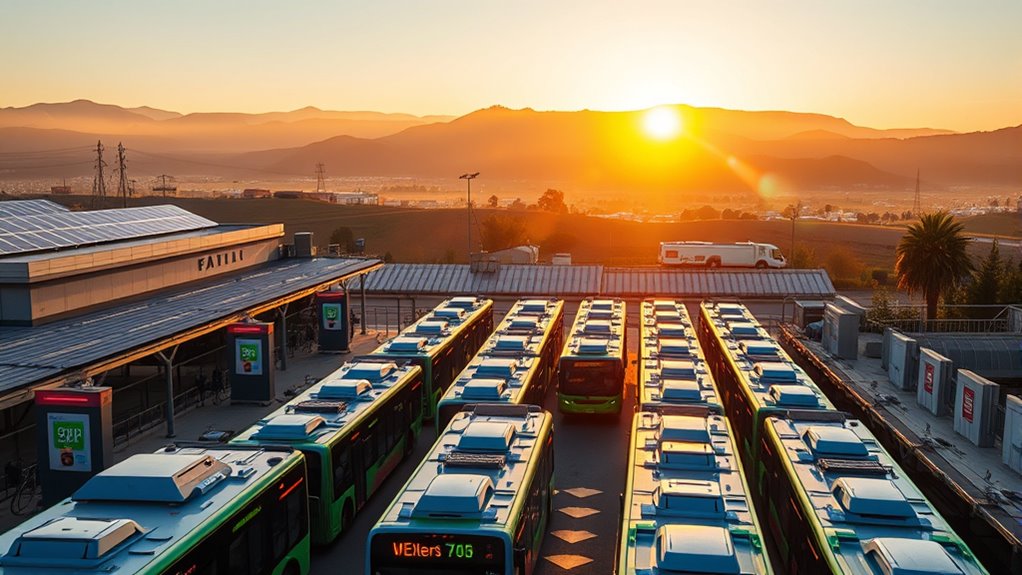California’s Clean Transit Rule requires transit agencies to meet specific milestones to shift to zero-emission buses by 2040. You can track compliance through regular reports and performance metrics that monitor progress. The state offers funding and support to help agencies stay on track, with adjustments made if needed. If you want to understand how agencies are meeting these goals and what’s being done to guarantee success, there’s more to discover ahead.
Key Takeaways
- Agencies must meet phased milestones through regular reporting to demonstrate progress toward the 2040 electric bus goal.
- Performance metrics are used to monitor compliance and ensure agencies stay on schedule for fleet electrification.
- Funding and infrastructure support are tied to compliance, incentivizing agencies to adhere to the rollout timeline.
- Support adjustments and additional resources are provided if agencies fall behind on their transition milestones.
- Transparency and accountability are maintained through ongoing tracking, enabling effective oversight of the transition process.

Have you ever wondered how California plans to cut transportation emissions? The state is taking bold steps through its Clean Transit Rule, which aims to shift public transportation fleets to cleaner, zero-emission vehicles by 2040. Central to this effort is the electric bus rollout, a key component designed to replace traditional diesel buses with electric-powered alternatives. As you follow this progress, you’ll see that the success of this rollout depends heavily on effective funding initiatives. These initiatives are vital for providing transit agencies with the financial support needed to purchase, operate, and maintain new electric buses, especially since upfront costs are higher than conventional models.
Funding initiatives in California focus on grants, incentives, and partnerships that lower the barriers for transit agencies to adopt clean technology. State and federal funds are allocated specifically for the electric bus rollout, ensuring that agencies with limited budgets can participate in the transition. These financial supports help cover the costs of infrastructure upgrades, such as charging stations and maintenance facilities, which are essential for supporting a fleet of electric buses. The goal is to make electric buses not just an environmentally friendly choice but also an economically feasible one for agencies of all sizes.
California’s funding efforts make electric buses affordable and accessible for transit agencies of all sizes.
You’ll notice that the rollout isn’t happening overnight. It’s a carefully phased plan that aligns with California’s broader climate goals. Agencies are required to meet specific milestones, gradually increasing their electric bus fleets over the years. To keep this process transparent and accountable, the state tracks agency compliance closely. This tracking involves regular reporting and performance metrics to ensure that each transit agency is on schedule to meet the 2040 goal. If an agency falls behind, additional support or adjustments are made to help them stay on course.
The electric bus rollout also encourages innovation, with some agencies experimenting with new charging technologies and operational strategies to maximize efficiency. Funding initiatives are flexible enough to support these innovative approaches, recognizing that technology evolves rapidly and requires ongoing investment. Additionally, the success of the transition depends on the availability of water parks, which often serve as community hubs and can facilitate outreach and educational efforts about clean transit. This adaptive funding structure helps California stay at the forefront of clean transit solutions, making that the transition to electric buses isn’t just a promise but a practical reality.
In short, California’s plan combines a strategic electric bus rollout with targeted funding initiatives to accelerate the shift away from fossil fuels. By supporting transit agencies financially and holding them accountable through compliance tracking, the state aims to lead the nation in clean transit. If successful, these efforts will dramatically reduce transportation emissions, improve air quality, and set a precedent for other states to follow.
Frequently Asked Questions
How Will Funding Be Allocated for Transit Agencies to Meet the Requirements?
Funding allocation for transit agencies will be prioritized through state and federal sources, providing financial incentives to support the shift to cleaner fleets. You’ll see targeted grants, subsidies, and investments designed to help agencies meet the requirements. These resources aim to reduce costs, encourage innovation, and guarantee compliance. By leveraging these financial incentives, agencies can upgrade their fleets efficiently, ultimately benefiting both the environment and transit riders.
What Penalties Exist for Non-Compliance With the Clean Transit Rule?
If you don’t comply with the clean transit rule, enforcement mechanisms come into play, including fines and penalties. You might face legal consequences like citations or orders to correct violations. In some cases, agencies could lose funding or face legal action. It’s essential to stay compliant to avoid these penalties, ensuring your transit operations meet the standards set by the rule and support California’s clean transit goals.
How Will Technological Advancements Impact the Transition Timeline?
Think of technology integration as a lighthouse guiding your fleet modernization efforts. As advancements accelerate, they can shorten the progression timeline by making electric and zero-emission buses more efficient and affordable. You’ll find that adopting innovative tech speeds up compliance, helping agencies meet the 2040 goal sooner. Embracing these changes allows you to navigate the shift smoothly, turning obstacles into opportunities for a cleaner, greener transit system.
Are Smaller Transit Agencies Exempt From Certain Regulations?
Small agency exemptions exist under certain conditions, providing regulatory flexibility to help them comply with California’s clean transit goals. If your agency operates fewer vehicles or has limited resources, you might qualify for these exemptions, easing the transition. This flexibility aims to support smaller agencies without penalizing them, allowing a smoother shift toward cleaner transit solutions. Stay informed on specific criteria to guarantee your agency benefits from these exemptions.
How Will Passenger Services Be Affected During the Transition Period?
Picture yourself on a bus, windows fogged from ongoing service disruptions during the changeover. You might notice temporary delays, route adjustments, or quieter rides as agencies upgrade their fleets. While these changes aim to improve the passenger experience long-term, expect some inconvenience now. Your daily commute could feel disrupted, but it’s part of the effort to create cleaner, more efficient transit services by 2040.
Conclusion
By 2040, California’s Clean Transit Rule will revolutionize how you experience transportation, making it cleaner and more sustainable than you ever imagined. As agencies race to meet strict deadlines, the impact will be nothing short of monumental—changing the very fabric of your daily commute. Staying compliant isn’t just important; it’s the key to a greener future that will outshine all others, transforming California into a beacon of innovation and environmental responsibility for generations to come.









